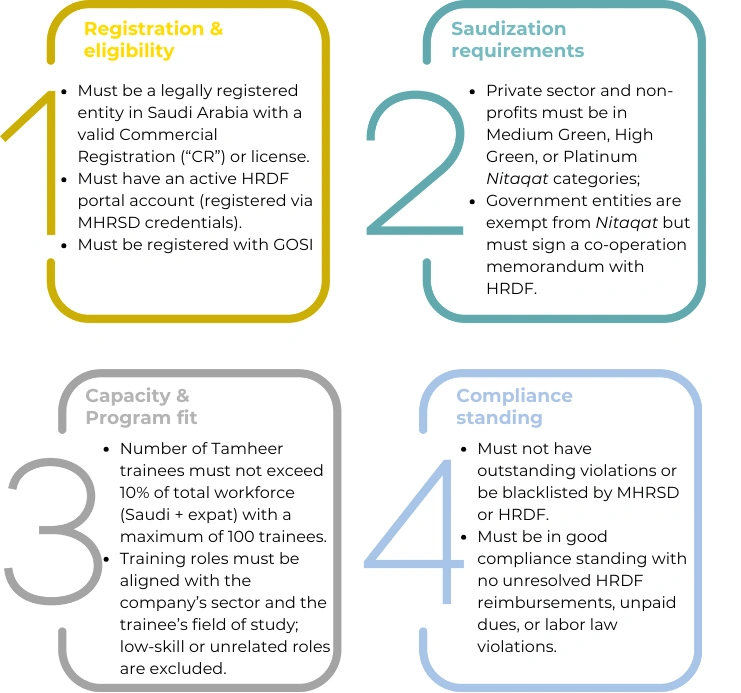GOVERNMENT INCENTIVES FOR HIRING & DEVELOPING SAUDI TALENT
Saudi graduate hiring incentives - Tamheer & Beyond

Excerpt
Saudi Arabia offers a range of government-backed programs through the Human Resources Development Fund (HRDF) to help employers attract, train, and retain Saudi talent. The flagship Tamheer program funds 3–6 months of full-time on-the-job training for fresh graduates, covering stipends, work-inju...
Executive Summary
Government-Funded Graduate Training Scheme in KSA (Tamheer Program)
Saudi Arabia offers a range of government-backed programs through the Human Resources Development Fund ("HRDF") to help employers attract, train, and retain Saudi talent. The flagship Tamheer program funds 3–6 months of full-time on-the-job training for fresh graduates, covering stipends, work-injury insurance, and e-learning, at no salary cost to the employer.
1. Overview of the scheme

Tamheer – the Graduate Development Program under Saudi Arabia's Human Resources Development Fund ("HRDF"). Launched via the national portal "Taqat" in 2017, Tamheer is an on-the-job training initiative for fresh Saudi graduates.

To support training and skill development of Saudi nationals who are fresh graduates, by placing them in practical workplace training before they become regular billable employees.
The program aims to bridge the gap between academic knowledge and workplace skills, improving graduates' employability.

- Saudi nationals, male or female, typically up to age 30, with no significant prior work experience (≤1 year).
- Must hold a diploma or higher degree from an accredited institution.
- Not currently registered on any company's GOSI payroll.
- Open, among others, to technical, health, administrative fields with no specific major or specialization requirement.

3 to 6 months of training support (the exact duration is determined by the host company but must be at least 3 months and not exceed 6 months).
Tamheer is capped at 6 months per trainee and there is no standard extension beyond 6 months.

Fixed monthly stipend paid by the government via HRDF: trainees with a bachelor's degree or higher receive SAR 3,000 per month, while those with a diploma qualification receive SAR 2,000 per month (no mandatory salary cost during the Tamheer training period for the host company). This stipend is intended to cover the training period and is paid directly to the trainee by the government on a monthly basis upon confirmation of attendance.
Introduction
Eligibility & compliance requirements
2. (a) Employer eligibility


Explanation
2. (b) Employee eligibility


- Must be a Saudi citizen (foreigners are ineligible).
- Maximum age of 30 years at the time of joining.
- No restriction on year of graduation; can apply immediately or later if other criteria are met.

- Must hold at least a diploma of one-year duration or a bachelor's degree or higher from a Saudi or internationally recognized university.
- Foreign degrees require Ministry of Education equivalency.

- Must not be currently employed in public or private sectors.
- Must not be registered as an active employee in GOSI at the time of joining.
- Must have one year or less of total prior work experience

- Must not have previously completed Tamheer; generally allowed only once (or twice if the first was incomplete) for a combined maximum of 6 months.
- Cannot be enrolled in another government-funded training or employment program at the same time.

- Must be registered on the HRDF portal and provide personal details including a local bank account (IBAN in their name).
- Must not be on HRDF's sanctions list.
- Must be available full-time for the training period; not eligible if a current student, part-time worker, retiree, or in military service.
2 (c) Compliance obligations of the host company
Training Agreement & Onboarding
- Company must sign an HRDF-format training agreement with each trainee, generated electronically once the trainee accepts the offer via the portal.
- Agreement includes training plan, duration, role/title, and mutual obligations.
Training Delivery & Work Environment
- Company must provide actual training aligned with the posted job description, assigning the trainee to a relevant department and supervisor/mentor.
- Prepare a clear training plan and deliver practical work experience, guidance, and evaluation.
Attendance & Monthly Reporting
- Company must confirm attendance in the Tamheer portal between the 13th and 17th of each month, recording absences.
- Trainees must maintain at least 75% attendance to complete the program successfully.
Progress Monitoring & Documentation
- Track trainee progress and provide evaluations when required; trainees also evaluate the program.
- Maintain records: agreements, attendance logs, assessments, and training activity logs.
- HRDF may audit records or investigate complaints, so detailed documentation is essential.
Payment Process & Administrative Accuracy
- No need for companies to request stipend payments, HRDF pays trainees directly.
- Ensure trainee's bank details are correct in the system.
- Correct administrative errors (e.g., wrong IBAN, missed attendance report) promptly with HRDF.
Conduct, Compliance & Enforcement
- Follow all HRDF program rules and labor law limits.
- Companies cannot charge trainees any fees or require financial contributions.
- HRDF monitors compliance; violations may lead to suspension, repayment of stipends, or other penalties.
3. Broad process to be followed by the Host Company


4. Cost summary
| Expense item | HRDF | Company |
|---|---|---|
| Monthly training stipend | SAR 3,000 (bachelor+) or SAR 2,000 (diploma) paid to trainee | SAR 0 required (company may add stipend optionally) |
| GOSI social insurance | trainee is not registered in GOSI | SAR 0 (no GOSI contributions needed; trainee not on payroll) |
| Medical insurance | Not provided by HRDF (trainee can use own insurance if any) | Not required (trainee isn't an employee). Some companies optionally extend clinic access or medical insurance, but purely voluntary |
| Training & supervision | HRDF offers e-learning modules at no cost; issues certificate | Company provides on-the-job training, supervision, workspace, etc (in-kind cost of mentoring and resources) |
| Post-training employment | If hired after Tamheer, other HRDF wage support programs may apply (see Section 5) | Company would start paying salary once trainee is hired as an employee (if they decide to hire) |
5. Post-program

- No legal or formal obligation to hire trainees after Tamheer; no penalties for not retaining them.
- Many companies use Tamheer as a talent pipeline and hire high-performing trainees when possible.
- If not hiring, provide professional feedback, reference letters, or recommendations to support the trainee's job search.

Hiring a Tamheer graduate may qualify the company for HRDF's Employment Wage Support program.
This can subsidize 30–50% of the Saudi hire's wage (up to SAR 3,000/month) for 24 months after hiring.
Program is independent of Tamheer and starts only after the trainee becomes a regular employee.
Check current HRDF schemes at the time of conversion for maximum benefit.

- Ensure the trainee receives their HRDF completion certificate (downloadable from the portal).
- Good practice to issue an experience or recommendation letter on company letterhead detailing the trainee's work and achievements.

- Maintain training records (agreements, attendance, assessments) for possible HRDF audits or follow-ups.
- A clean compliance record benefits future applications to HRDF programs.

- Recover company property, disable system access, and settle any company-provided benefits.
- No entitlement to end-of-service benefits as trainees are not employees.
- Consider having trainees sign NDAs or confidentiality acknowledgments, especially if they worked on sensitive or proprietary projects.
- Ensure ownership rights to any work created during the training are secured in writing.

- Companies can host future Tamheer trainees, respecting eligibility and simultaneous trainee limits.
- Successful Tamheer participation can enhance reputation and align with Vision 2030 and CSR objectives.
- Share positive outcomes (e.g., hires, trainee success stories) publicly or via HRDF's success stories platform.
Other relevant government incentive programs

A core HRDF initiative to incentivize private sector hiring of Saudi nationals by subsidizing 30–50% of their monthly wage for up to 24 months (capped at SAR 3,000/month). Works well as a follow-on to Tamheer for retaining high-performing graduates.
- Covers all private sector industries and occupations.
- Employee must be Saudi, aged 18–60, earning SAR 4,000–15,000, and not a student or already employed.
- Employer must be compliant, have an active HRDF account, and apply through Taqat within the program window.
- Cannot overlap with Tamheer for the same individual; sequential use is allowed.

Government-funded programs that reduce barriers to female workforce participation.
- Wusool: Covers up to 80% of transport costs (e.g., ride-hailing services) up to a monthly cap.
- Qurrah: Provides financial support for registered daycare/nursery fees for children up to a set age.
- Saudi women in the private sector, earning below set salary caps, registered in GOSI are eligible for both programs.
- Employees apply directly; employer's role is to promote awareness and facilitate access.
By combining Tamheer for training new graduates with Employment Support for hiring and other support schemes, Newgen KSA can significantly reduce its talent acquisition costs while contributing to national workforce development.
Caveat
This is a compilation based on publicly available information from official government sources. All details are provided for general guidance only, and program rules, criteria, processes, and funding levels may change without notice.
Please seek professional advice prior to making any decision.